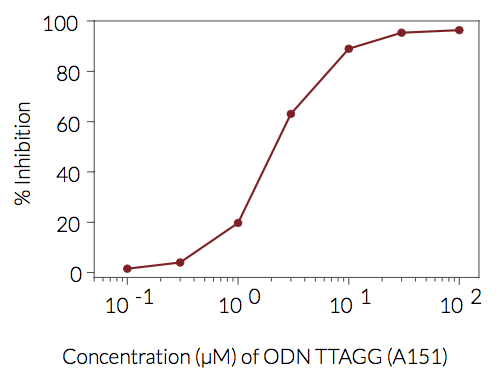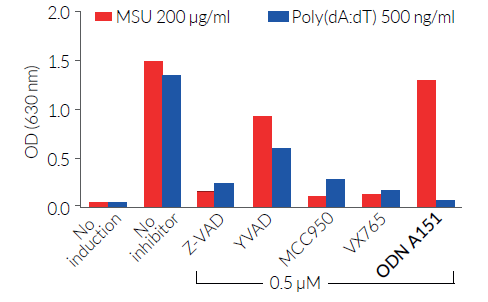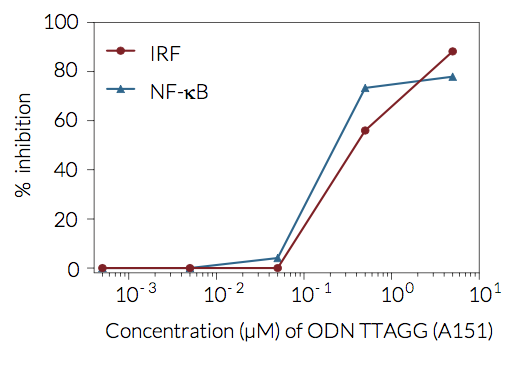
ODN TTAGGG (A151)
| ODN TTAGGG (A151) | Unit size | Cat. code | Docs | Price |
|---|---|---|---|---|
TLR9 antagonist - Human preferred | 200 µg 1 mg | tlrl-ttag151 | TDSMSDSDATA | Please contact our distributor Add to favorite |
- About
- Specifications
- Contents
- Citations
Suppressive oligonucleotide - TLR9, AIM2 and cGAS antagonist
ODN TTAGGG (A151), also known simply as A151, is a synthetic oligonucleotide (ODN) containing 4 repeats of the immunosuppressive TTAGGG motif commonly found in mammalian telomeric DNA [1].
This ODN was initially identified as a TLR9 antagonist that inhibits immune activation by CpG-containing ODNs [2].
Subsequently, additional targets for this inhibitor were found: by binding to the cytosolic DNA sensors (CDSs) AIM2 and IFI16, A151 prevents AIM2 inflammasome activation [3,4].
This ODN is also described as a cGAS inhibitor, acting through competition with DNA [1].
Overall, these findings show that ODN TTAGGG (A151) is a multiple pattern recognition receptors (PRR) suppressor that can prove useful for immunomodulatory studies.
References:
1. Steinhagen F. et al., 2017. Suppressive oligodeoxynucleotides containing TTAGGG motifs inhibit cGAS activation in human monocytes. Eur J Immunol. DOI: 10.1002/ eji.201747338.2. Gursel I. et al, 2003. Repetitive elements in mammalian telomeres suppress bacterial DNA-induced immune activation. J Immunol. 171(3):1393-400.3. Eichholz K. et al., 2016. Immune-Complexed Adenovirus Induce AIM2-Mediated Pyroptosis in Human Dendritic Cells. PLoS Pathog. 12(9):e1005871.4. Kaminski J. et al., 2013. Synthetic oligodeoxynucleotides containing suppressive TTAGGG motifs inhibit AIM2 inflammasome activation. J Immunol. 191(7):3876-83.
Figures
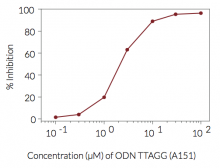
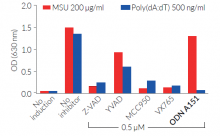
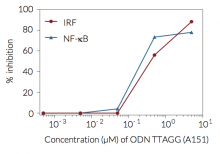
Specifications
Working concentration: 100 nM - 10 µM
Solubility: 5 mg/ml in water
Molecular weight: 7944 g/mol
ODN TTAGGG sequence5’- tt agg gtt agg gtt agg gtt agg g -3’ (24 mer)Note: Bases are phosphorothioate-linked (nuclease resistant).
Quality control:- Biological activity has been tested using HEK-Blue™ TLR9 cells.- The absence of bacterial contamination (e.g. lipoproteins and endotoxins) has been confirmed using HEK-Blue™ TLR2 and HEK-Blue™ TLR4 cells.
Back to the topContents
ODN TTAGGG (A151) is provided lyophilized and is available in two quantities.
tlrl-ttag151:
- 200 μg (25.2 nmol) lyophilized ODN TTAGGG (A151)
- 1.5 ml endotoxin-free water
tlrl-ttag151-1:
- 1 mg (126 nmol) lyophilized ODN TTAGGG (A151)
- 1.5 ml endotoxin-free water
![]() ODN TTAGGG (A151) is shipped at room temperature.
ODN TTAGGG (A151) is shipped at room temperature.
![]() Upon receipt, store at -20 °C.
Upon receipt, store at -20 °C.
Citations

2020 J Invest Dermatol. DOI: 10.1016/j.jid.2019.09.029
RNase 7 promotes sensing of self-DNA by human keratinocytes and activates an antiviral immune response.
Kopfnagel V. et al.

2017 Nat Commun. 8(1):1282.
Plasmodium DNA-mediated TLR9 activation of T-bet+ B cells contributes to autoimmune anaemia during malaria.
Rivera-Correa J. et al.

2015 J Exp Med. 212(2):129-37.
Phosphorothioate backbone modifications of nucleotide-based drugs are potent platelet activators.
Flierl U, Nero TL, Lim B, Arthur JF, Yao Y, Jung SM, Gitz E, Pollitt AY, Zaldivia MT, Jandrot-Perrus M, Schäfer A, Nieswandt B, Andrews RK, Parker MW, Gardiner EE, Peter K.

2014 J Leukoc Biol.95(6):983-91.
Diversion of the host humoral response: a novel virulence mechanism of Haemophilus influenzae mediated via outer membrane vesicles.
Deknuydt F, Nordström T, Riesbeck K.

2013 Ann Rheum Dis. 72(3):418-26.
Ligation of TLR7 by rheumatoid arthritis synovial fluid single strand RNA induces transcription of TNFα in monocytes.
Chamberlain ND, Kim SJ, Vila OM, Volin MV, Volkov S, Pope RM, Arami S, Mandelin AM 2nd, Shahrara S.

2012 Blood 119(12):2810-2818
Oligodeoxynucleotides stabilize Helios-expressing Foxp3+ human T regulatory cells during in vitro expansion.
Kim YC, Bhairavabhotla R, Yoon J, Golding A, Thornton AM, Tran DQ, Shevach EM
Load moreebiomall.com










